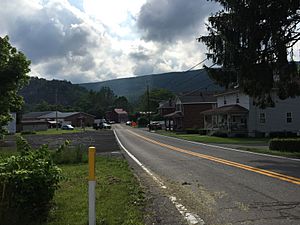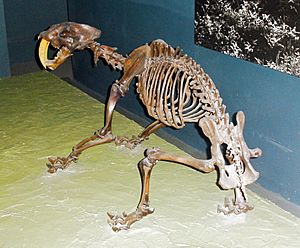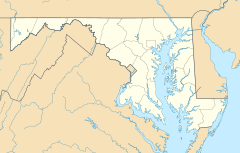Corriganville, Maryland facts for kids
Quick facts for kids
Corriganville, Maryland
|
|
|---|---|

Kreighbaum Road in Corriganville
|
|
| Country | |
| State | |
| County | |
| Area | |
| • Total | 0.36 sq mi (0.94 km2) |
| • Land | 0.36 sq mi (0.94 km2) |
| • Water | 0.00 sq mi (0.00 km2) |
| Elevation | 866 ft (264 m) |
| Population
(2020)
|
|
| • Total | 421 |
| • Density | 1,166.20/sq mi (449.79/km2) |
| Time zone | UTC−5 (Eastern (EST)) |
| • Summer (DST) | UTC−4 (EDT) |
| ZIP code |
21524
|
| FIPS code | 24-19975 |
| GNIS feature ID | 2583601 |
Corriganville is a small community in Allegany County, Maryland, United States. It's known as a census-designated place (CDP). This means it's a special area defined by the government for gathering population data.
In 2020, about 421 people lived in Corriganville. It is part of the larger Cumberland, MD-WV Metropolitan Statistical Area. This area includes nearby cities and towns.
A local business in Corriganville is the Cumberland Cement and Supply Company. They operate a quarry, which is a place where they dig up rocks. They mine limestone and shale from the ground.
Contents
Exploring Corriganville's Location
Corriganville is located north of the city of Cumberland. It sits where two waterways meet: Wills Creek and Jennings Run.
Two main roads pass through or near Corriganville. Maryland Route 36 goes right through the community. From Corriganville, Maryland Route 35 heads north towards another town called Ellerslie.
Population Facts
| Historical population | |||
|---|---|---|---|
| Census | Pop. | %± | |
| 2020 | 421 | — | |
| U.S. Decennial Census | |||
The population of Corriganville was last counted in 2020. At that time, 421 people lived there.
Discovering the Cumberland Bone Cave

In 1912, something amazing was found near Corriganville. Workers were digging for the Western Maryland Railway when they broke into a cave. This cave was partly filled with dirt and rocks. It was located on the side of Wills Mountain.
A local nature expert named Raymond Armbruster noticed something special. He saw fossil bones among the rocks that had been blasted loose. He quickly told scientists at the Smithsonian Institution. Soon after, a paleontologist named James W. Gidley started digging at the site that same year. This cave later became famous as the Cumberland Bone Cave.
What Was Found in the Cave?
Between 1912 and 1916, James Gidley and his team explored the Cumberland Bone Cave. They found fossils from 41 different types of mammals! About 16 percent of these animals are now extinct, meaning they no longer exist on Earth.
Scientists found many excellent skulls and enough bones to put together full skeletons for some of the animals. For example, skeletons of the Pleistocene cave bear and an extinct saber-toothed cat from the Bone Cave are now on display. You can see them in the Ice Age Mammal exhibit at the National Museum of Natural History, which is part of the Smithsonian Institution in Washington, D.C..
Many of these fossilized bones are incredibly old, dating back about 200,000 years. The Cumberland Bone Cave is considered one of the best places in eastern North America to find fossils from the Pleistocene era.
Notable People from Corriganville
- Sergeant Joseph Darby grew up in Corriganville.
See also
 In Spanish: Corriganville para niños
In Spanish: Corriganville para niños



